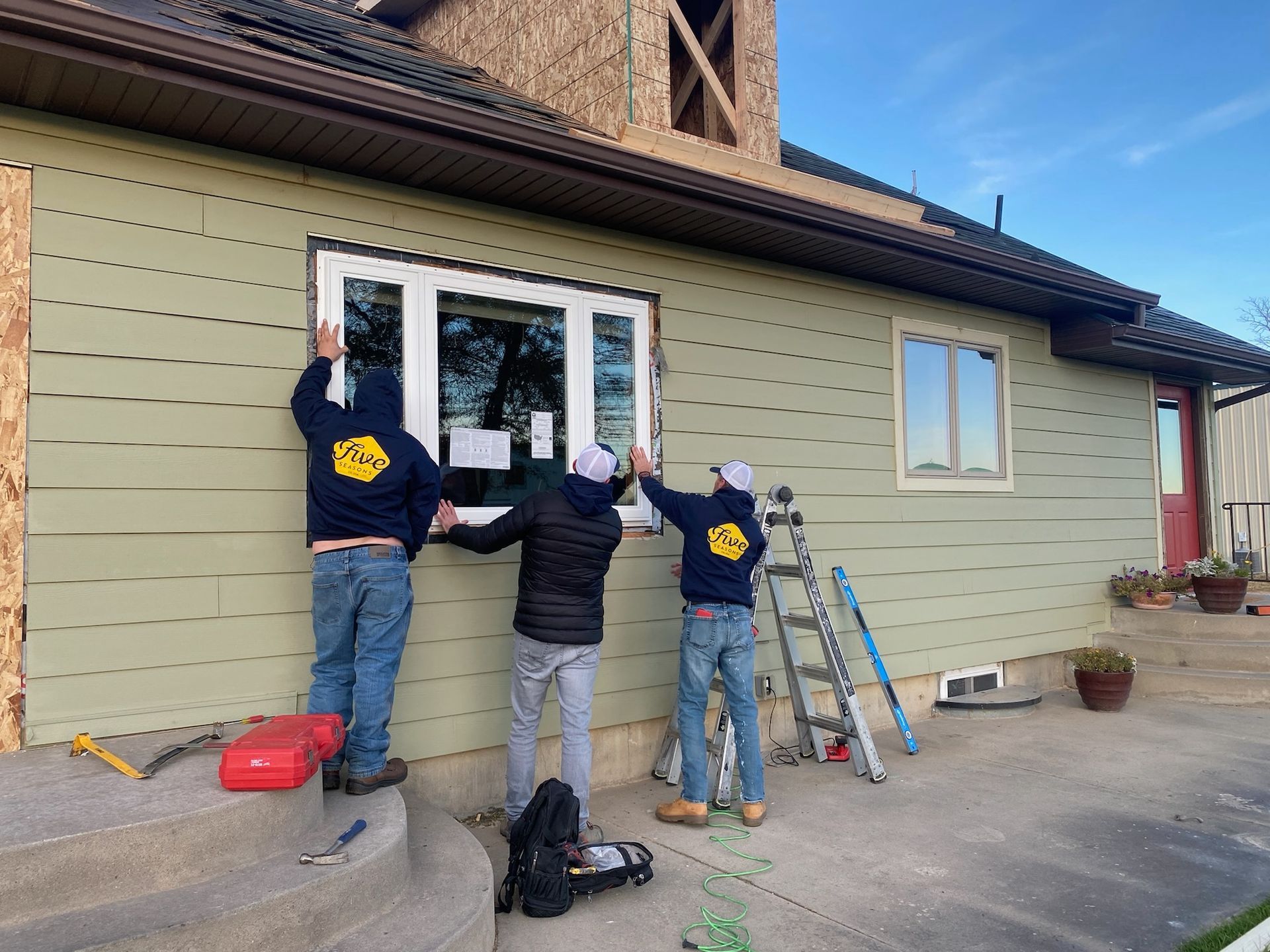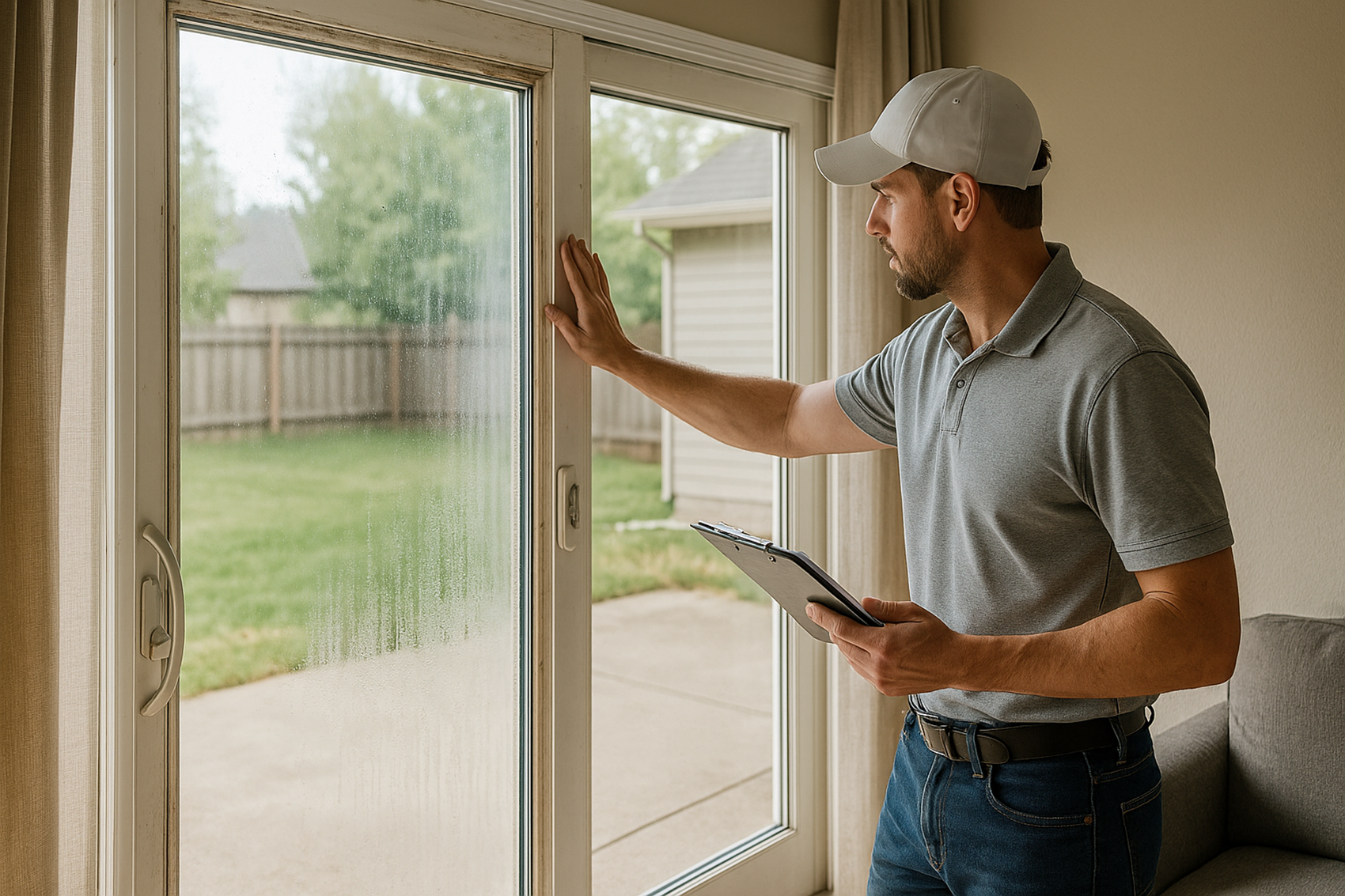When to replace patio doors depends primarily on age exceeding 15-20 years for standard doors or observable performance issues including drafts, condensation between glass panes, difficult operation, visible damage, or energy bills increasing despite consistent usage patterns. Modern patio doors offer significant performance improvements over older models through advanced glazing, improved weatherstripping, and thermally efficient frames that justify replacement even before complete failure occurs.
According to the National Association of Home Builders, patio doors older than 15-20 years typically show measurable performance degradation including 30-50% reduced energy efficiency, compromised weather sealing, and increased maintenance requirements that make replacement more cost-effective than continued repairs. These age-related declines combine with modern door improvements to create compelling replacement timing opportunities.
Understanding specific age benchmarks and performance indicators helps homeowners recognize optimal replacement timing that balances ongoing costs against new door benefits, ensuring replacement decisions maximize value while addressing functional problems before they escalate into more serious issues.
Age-Based Replacement Guidelines
Standard Door Lifespan Expectations
Patio doors typically require replacement after 15-20 years of service as materials degrade, seals fail, and technology becomes outdated compared to modern energy-efficient alternatives. This timeframe applies to standard quality doors with typical maintenance under normal use conditions and moderate climate exposure.
Higher quality doors with premium materials and proper maintenance may extend service life to 20-25 years, while budget installations or harsh climate exposure can reduce effective lifespan to 12-15 years. Age alone doesn't mandate replacement, but serves as indicator for increased inspection frequency and performance evaluation.
Material-Specific Age Considerations
Different frame materials age at different rates affecting optimal replacement timing. Vinyl frames typically last 20-25 years before material degradation becomes noticeable, while aluminum frames may show wear after 15-20 years particularly in coastal or high-moisture environments where corrosion accelerates aging.
Wood and wood-clad patio doors require replacement after 15-20 years unless exceptional maintenance prevents rot, warping, or moisture damage that commonly affects wood products. Fiberglass frames offer longest service life often exceeding 25-30 years before replacement becomes necessary, making them preferred choices for long-term installations.
Energy Efficiency Decline
Rising Utility Bills and HVAC Runtime
Increasing heating and cooling costs despite stable usage patterns indicate patio door energy efficiency degradation that wastes money through air infiltration and thermal transfer. Monthly utility bills rising 15-20% or more without corresponding usage increases often trace to failing door performance requiring replacement.
Aging doors lose efficiency through seal failures, frame deterioration, and glazing degradation that forces HVAC systems to run longer maintaining comfortable temperatures. This increased runtime not only raises energy costs but also accelerates HVAC wear requiring more frequent maintenance and earlier equipment replacement.
Seal Failures and Insulation Loss
Failed weatherstripping and gasket seals allow air infiltration that dramatically reduces door thermal performance. Visible gaps around door perimeters, feeling drafts near closed doors, or seeing daylight through door edges indicate seal problems requiring immediate attention and often justifying complete door replacement.
Insulated glass unit seal failures allowing moisture between panes represent irreversible damage requiring glass replacement or full door replacement. These failures eliminate insulating gas fills and create permanent fogging that ruins views while destroying thermal performance that makes modern doors energy efficient.
Visible Damage and Deterioration
Frame and Glass Damage
Cracked, chipped, or broken glass represents obvious replacement triggers requiring immediate action for security and safety reasons. Frame damage including warping, cracking, rotting wood, or separated joints compromises structural integrity and weather resistance justifying replacement even if glass remains intact.
Visible corrosion on metal frames, particularly aluminum exposed to moisture or salt environments, indicates material degradation that weakens structure and accelerates failure. Surface damage may reflect deeper deterioration requiring professional evaluation to determine repair feasibility versus replacement necessity.
Weather Damage and Moisture Problems
Water stains, rot, or mold around door frames indicate moisture infiltration from failed weather barriers requiring immediate attention. Interior moisture problems often signal more extensive damage than visible symptoms suggest, with hidden rot or structural damage discovered during replacement making earlier intervention more cost-effective.
Exterior weathering including peeling paint, faded finishes, or surface deterioration beyond cosmetic concern indicates material breakdown that compromises protection and accelerates further damage. These visible indicators often accompany hidden performance problems justifying comprehensive replacement rather than surface repairs.
Operation and Functionality Problems
Difficult Opening or Closing
Doors requiring excessive force to operate, sticking in tracks, or binding during movement indicate alignment problems, hardware wear, or frame warping requiring repair or replacement. These operation difficulties typically worsen over time as underlying causes continue degrading performance and safety.
Sliding doors jumping tracks, coming off rollers, or requiring lifting to close properly signal serious mechanical problems that create security vulnerabilities and safety hazards. While hardware replacement sometimes resolves operation issues, persistent problems often indicate frame or structural damage necessitating complete door replacement.
Lock and Security Failures
Locks that don't engage properly, latches that slip, or security bars that don't function correctly compromise home security requiring immediate attention. Worn hardware can sometimes be replaced, but aged doors often have discontinued parts or incompatible modern security upgrades making replacement more practical.
The combination of mechanical problems and security concerns in aging doors creates compelling replacement justification even without energy efficiency issues. Modern doors offer significantly improved security features including multi-point locking systems and reinforced frames that older doors cannot match through upgrades alone.
Condensation and Moisture Issues
Between-Pane Condensation
Moisture appearing between insulated glass panes indicates complete seal failure requiring glass unit replacement at minimum and often justifying full door replacement depending on door age and condition. This condensation cannot be eliminated without replacing failed sealed units, making it permanent until corrective action.
The presence of between-pane moisture eliminates insulating properties of sealed units and creates permanent fogging that ruins views and appearance. Combined with lost insulating gas fills and reduced R-values, this failure typically occurs after 10-15 years in standard doors and signals optimal replacement timing.
Interior Condensation and Drafts
Excessive interior condensation on glass surfaces despite adequate humidity control indicates poor thermal performance allowing cold glass temperatures that create condensation. While some condensation in extreme conditions is normal, persistent problems suggest inadequate insulation requiring door performance evaluation.
Feeling drafts near closed doors or noticing temperature differences in areas adjacent to patio doors indicates air infiltration from failed weather seals or alignment problems. These performance issues waste energy while reducing comfort and typically worsen progressively until door replacement addresses root causes.
Cost Analysis and ROI Timing
Repair Costs Versus Replacement Value
When repair costs exceed 30-40% of new door installation costs, replacement typically provides better long-term value through improved energy efficiency, modern features, and extended service life. Cumulative repair expenses over 2-3 years often justify replacement that eliminates ongoing maintenance while upgrading performance.
Major repairs including glass replacement, frame reconstruction, or extensive hardware updates may cost $500-1,500 while quality new door installation ranges $1,500-4,000 depending on size and features. This cost comparison often favors replacement particularly for doors already approaching age-based replacement guidelines.
Energy Savings Payback Calculations
Modern energy-efficient patio doors typically save $150-400 annually compared to 15-20 year old doors through reduced heating and cooling costs. These savings create 5-10 year payback periods making replacement financially justifiable even without considering comfort improvements or deferred maintenance expenses.
The combination of energy savings, avoided repair costs, and improved home value through door replacement often creates positive ROI within 7-10 years for typical installations. Earlier replacement of significantly underperforming doors can shorten payback periods through immediate utility bill reductions.
For homeowners considering patio door replacement, understanding space-efficient design options can help maximize both functional improvements and spatial benefits during upgrades. For comprehensive information about sliding door advantages and space optimization strategies, explore our detailed guide: 🔗 Why Choose Sliding Patio Door Installation for Space-Saving Benefits

People Also Ask About When to Replace Patio Doors
1. How long do patio doors typically last before needing replacement?
Patio doors typically last 15-20 years before replacement becomes necessary due to age-related performance degradation, with higher quality installations potentially extending to 20-25 years through proper maintenance. Material type significantly affects lifespan with fiberglass doors lasting 25-30 years, vinyl 20-25 years, and wood or aluminum 15-20 years under normal conditions.
Harsh climates with extreme temperatures, high UV exposure, or salt air can reduce service life by 20-30% through accelerated material degradation and seal failures. Conversely, mild climates with proper maintenance and high-quality installations may extend door life beyond typical ranges.
However, age alone shouldn't determine replacement timing as performance indicators including energy efficiency, operation quality, and visible condition provide better replacement decision criteria than calendar years. Doors showing significant problems before reaching typical lifespan should be replaced regardless of age, while well-performing doors may continue service beyond average timelines.
2. What are the most common signs that patio doors need replacement?
The most common replacement signs include visible condensation between glass panes indicating seal failure, feeling drafts around closed doors showing weatherstripping problems, difficult operation suggesting alignment or hardware issues, and rising energy bills despite consistent usage patterns indicating thermal performance degradation.
Additional warning signs include visible damage such as cracked glass, warped frames, rotting wood, or corroded metal components that compromise structural integrity and weather resistance. Lock malfunctions, security concerns, or doors that don't close properly also signal replacement needs.
The combination of multiple indicators provides strongest replacement justification as problems typically cluster once doors begin failing. A single minor issue might warrant repair, but multiple simultaneous problems usually indicate systematic age-related decline making replacement more cost-effective than addressing individual symptoms.
3. Can you repair patio doors or should you replace them?
Repair feasibility depends on problem extent, door age, and cost comparison with replacement. Minor issues including hardware replacement, weatherstripping updates, or roller adjustments often make economic sense for doors under 10 years old without systemic problems.
However, major repairs including glass unit replacement, frame reconstruction, or addressing structural damage typically cost 30-50% of new door installation while providing only short-term fixes without performance improvements. For doors over 15 years old or showing multiple problems, replacement usually provides better long-term value.
The decision should consider total cost of ownership including ongoing repair expenses, energy waste from reduced efficiency, and deferred benefits of modern door features. Professional evaluation can assess whether repairs will meaningfully extend service life or merely postpone inevitable replacement.
4. How do you know if your patio door is energy efficient enough?
Energy efficiency can be assessed through utility bill analysis comparing current costs to previous years adjusted for rate changes, feeling for drafts or temperature differences near closed doors, and checking for visible condensation or frost formation indicating thermal performance problems.
Professional energy audits using thermal imaging can quantify heat loss through doors and compare performance to modern standards. Doors achieving U-factors below 0.30 and meeting ENERGY STAR requirements for your climate zone provide acceptable efficiency, while higher values indicate replacement opportunities.
Modern doors offer 30-50% better energy performance than 15-20 year old installations through advanced Low-E coatings, improved gas fills, and better frame insulation. This efficiency gap often justifies replacement through energy savings alone without considering comfort or operational improvements.
5. What is the best time of year to replace patio doors?
The best replacement timing is spring or fall when moderate temperatures allow comfortable installation without extreme heating or cooling loss during the process. Spring installation prepares homes for summer cooling efficiency while fall replacement optimizes winter heating performance.
Avoiding peak summer heat or winter cold makes installation more comfortable for contractors and homeowners while reducing temporary climate control challenges during work. However, quality contractors can install doors year-round using protective measures and efficient processes minimizing weather exposure.
Scheduling considerations should balance weather preference against contractor availability, seasonal pricing variations, and urgency of existing door problems. Severe performance issues requiring immediate attention shouldn't wait for ideal weather, while planned upgrades can optimize timing for best conditions and pricing.
Our Take
At Five Seasons Windows & Doors, we recommend proactive patio door replacement based on age and performance indicators rather than waiting for complete failure that often occurs during inconvenient times. Our installation experience throughout Colorado shows that homeowners replacing doors at 15-20 years or when performance problems emerge avoid emergency situations while maximizing new door benefits through planned timing.
Colorado's challenging climate with extreme temperature swings, intense UV exposure, and unpredictable weather accelerates patio door aging compared to moderate climates. We regularly see 15-year-old doors showing performance degradation that justifies replacement through energy savings and comfort improvements, particularly when comparing to modern door technologies from manufacturers like Marvin, ProVia, and Anlin.
We believe planned patio door replacement based on objective age and performance criteria provides better value than reactive replacement after complete failure. This proactive approach allows careful product selection, optimal timing for installation scheduling, and maximized energy savings rather than emergency replacement under time pressure and limited options.
Final Takeaway
When to replace patio doors depends on age exceeding 15-20 years or performance problems including energy efficiency decline, operation difficulties, visible damage, or moisture issues that reduce functionality and increase ongoing costs. Understanding these replacement indicators helps homeowners recognize optimal timing that balances continued use against new door benefits.
The combination of age-based guidelines and specific performance problems provides comprehensive framework for replacement decisions that maximize value while avoiding premature replacement or delayed action allowing problems to worsen. Professional evaluation can confirm replacement necessity and identify appropriate modern alternatives.
Proactive patio door replacement based on objective criteria ensures homes maintain optimal energy efficiency, security, and comfort while avoiding emergency situations requiring rushed decisions and potentially compromising product selection or installation timing for best results.
Get Started Today
Five Seasons Windows & Doors is Colorado’s top-rated local window company with 230+ 5-star reviews. We offer expert advice, no-pressure quotes, and flexible project options — including phased installs. Schedule your consult today.




